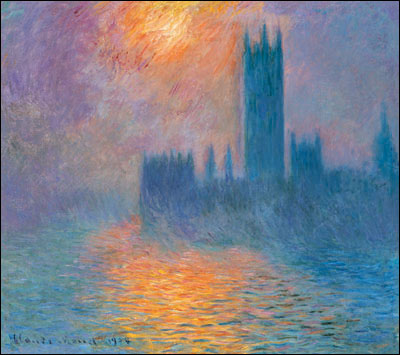
Claude Monet ,Parliament Sunset , 1904.
Oil on cloth, 81 x 92 cm, Kunsthaus Zürich.
|
|
Galeries Nationales du Grand Palais
Square Jean Perrin Entrance
75008 Paris - France
Information
Tel. +33 1 44 13 17 17
www.rmn.fr/turner-whistler-monet
e-mail : information.gngp@rmn.fr
Opening Times
Every day, except Tuesdays, 10:00 am to 8:00 pm,
Wednesdays, from 10:00 am to 10:00 pm.
Ticket office closes 45 minutes before closing time.
Closed 25th December.
Entrance Fees
With reservation, from 10:00 am to 1:00 pm 11,10 €.
Without reservation, from 1:00 pm:
Full price 10 €. Concessions 8 €.
Free for children under 13, unemployed and pensioners.
Advisory Committee
Sylvie PATIN, Musée d' Orsay, Paris, curator of the exhibition in Paris.
Katharine LOCHNAN, Musée des Beaux-Arts de l'Ontario, Toronto.
Alison SMITH, Tate, London.
Ian WARRELL, Tate, London.
John HOUSE, Courtauld Institute of Art, London.

|
Another way of celebrating the Entente Cordiale centennial , this exhibition is an opportunity to study the relationship between Monet’s first paintings of the Thames, in 1871, and the “series” he painted in London in 1899, 1900 and 1901 in the light of many paintings, watercolours and etchings by Turner and Whistler.
The London fog
At the end of 1870, Claude Monet moved to London to escape the Franco-Prussian war. He was thirty at the time and stayed in London for several months. There he discovered the work of William Turner (1775-1851) on show in the National Gallery. At the same period he probably visited the studio of James Whistler (1834-1903) and may well have seen the American artist’s earliest Nocturnes. As a very young man, on one of his first visits to London, Whistler, too, had been intrigued by Turner’s work. During his stay the French artist painted three views of the Thames wreathed in fog during his stay. The works of Turner and Whistler certainly had an influence, although it is hard to define, on the man who later became the prime mover of the Impressionist movement, especially on the famous Impression Sunrise, whose title, by derision, became the name of the new art movement.
Another Entente Cordiale
A steadfast friendship later developed between Whistler and Monet and they helped each other exhibit their works in London and Paris. Thanks to Monet, Parisians had an opportunity to see a collection of Whistler’s paintings, watercolours and pastels at the International Exhibition at the Georges Petit Gallery in May-June 1887, and thanks to Whistler, Monet’s paintings were admired by Londoners at the Royal Society of British Artists in November-December of the same year. Following the lead of Turner and Whistler, Monet tried to show what he called “fog effects” over the Thames and the Seine. Apart from the purely aesthetic side of his research, these paintings show the air pollution caused by the clouds of smoke belching from factory chimneys. Monet returned to the same motif in an extraordinary way some twenty-five years later, when he stayed in London, indulging in real “painting binges” which were one of the high points of his oeuvre.
At the end, the exhibition brings face to face works by the three painters in Venice, where Monet went in 1908. His views of the Grand Canal and the island of San Giorgio Maggiore have direct links with the views of London he had painted several years before.
PUBLICATIONS
Exhibition catalogue, 264 pages, € 39, published jointly by Tate publishing /RMN.
Petit Journal des expositions, € 3, RMN.
This exhibition will be presented from 12 February to 15 May 2005 at the Tate Britain, London.
|








